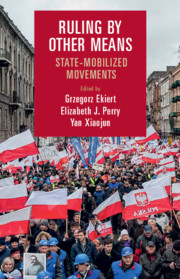Book contents
- Ruling by Other Means
- Cambridge Studies in Contentious Politics
- Ruling by Other Means
- Copyright page
- Contents
- Figures
- Tables
- Contributors
- Acknowledgments
- 1 State-Mobilized Movements: A Research Agenda
- 2 Manufactured Ambiguity
- 3 Suppressing Students in the People’s Republic of China
- 4 State-Mobilized Community Development
- 5 Enforcement Networks and Racial Contention in Civil Rights–Era Mississippi
- 6 Social Sources of Counterrevolution
- 7 Occupy Youth!
- 8 State-Mobilized Movements after Annexation of Crimea
- 9 Mirroring Opposition Threats
- 10 Mobilizing against Change
- 11 The Dynamics of State-Mobilized Movements
- 12 State-Mobilized Campaign and the Prodemocracy Movement in Hong Kong, 2013–2015
- 13 The Resurrection of Lei Feng
- Index
- Books in the Series (continued from p.iii)
- References
10 - Mobilizing against Change
Veteran Organizations as a Pivotal Political Actor
Published online by Cambridge University Press: 29 July 2020
- Ruling by Other Means
- Cambridge Studies in Contentious Politics
- Ruling by Other Means
- Copyright page
- Contents
- Figures
- Tables
- Contributors
- Acknowledgments
- 1 State-Mobilized Movements: A Research Agenda
- 2 Manufactured Ambiguity
- 3 Suppressing Students in the People’s Republic of China
- 4 State-Mobilized Community Development
- 5 Enforcement Networks and Racial Contention in Civil Rights–Era Mississippi
- 6 Social Sources of Counterrevolution
- 7 Occupy Youth!
- 8 State-Mobilized Movements after Annexation of Crimea
- 9 Mirroring Opposition Threats
- 10 Mobilizing against Change
- 11 The Dynamics of State-Mobilized Movements
- 12 State-Mobilized Campaign and the Prodemocracy Movement in Hong Kong, 2013–2015
- 13 The Resurrection of Lei Feng
- Index
- Books in the Series (continued from p.iii)
- References
Summary
On 18 November 2016, around 100,000 people marched from the Vukovar city centre to the cemetery, commemorating Vukovar Remembrance Day, the twenty-fifth anniversary of the day when Vukovar fell into the hands of Serbian occupying forces in 1991. The event was organized by local veteran organizations and attended by the prime minister and his cabinet, the president, army chiefs of staff, numerous MPs, generals, and other notables from the political elite. Following the September election that year, both the parliamentary majority and the presidency were in the hands of the right-wing party Hrvatska Demokratska Zajednica (HDZ), and the entire party leadership was in attendance. Participants came to Vukovar from all parts of Croatia, including some from neighbouring Bosnia and Herzegovina, many of them draped in Croatian flags, others carrying military insignia from the Homeland War. After laying the wreaths at the city cemetery to commemorate soldiers and civilians who died in Vukovar during the war, the Catholic archbishop held mass.
- Type
- Chapter
- Information
- Ruling by Other MeansState-Mobilized Movements, pp. 239 - 260Publisher: Cambridge University PressPrint publication year: 2020
References
- 1
- Cited by



